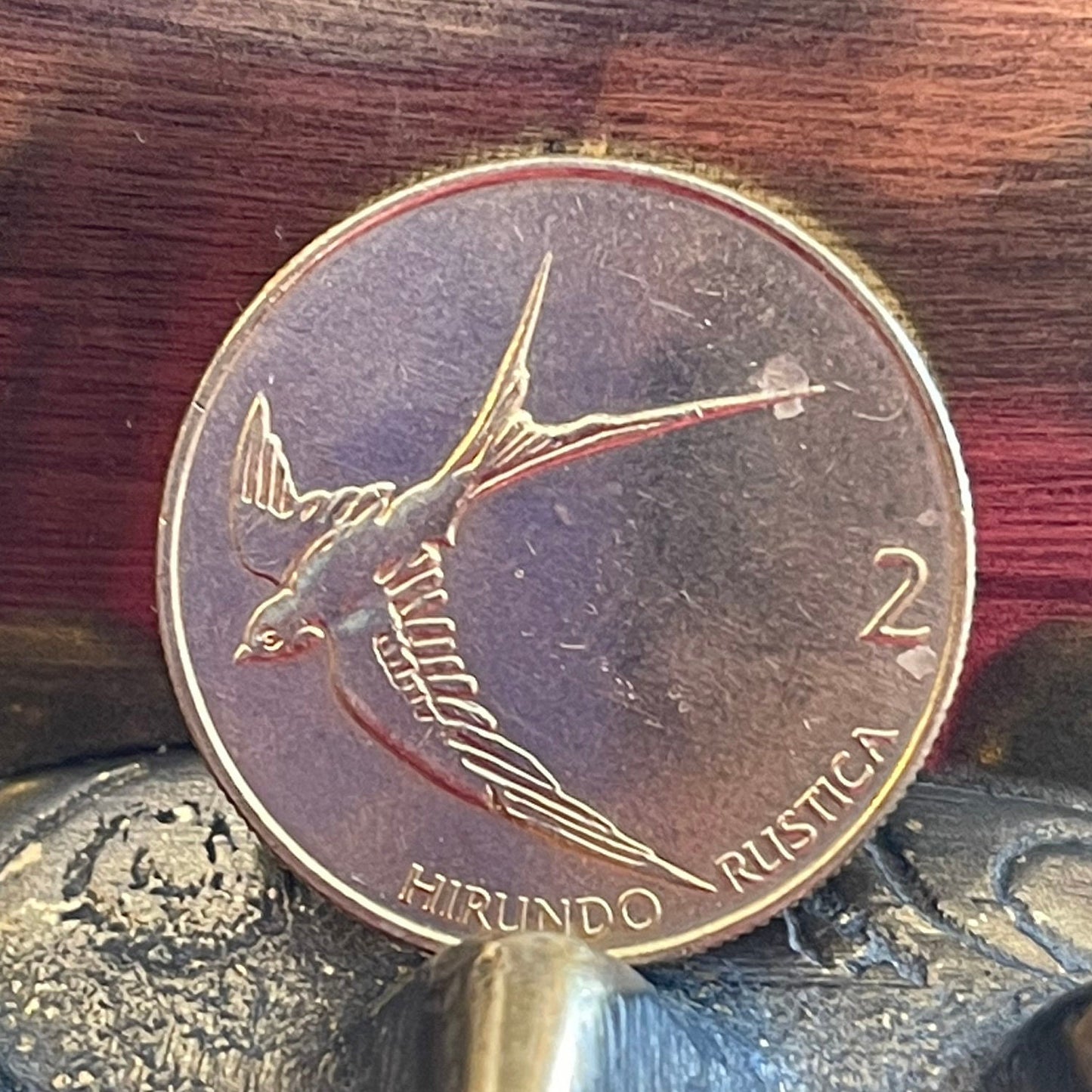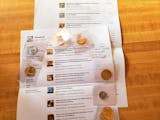elemintalshop
Barn Swallow Slovenia 2 Tolarja Authentic Coin Money for Jewelry and Craft Making
Barn Swallow Slovenia 2 Tolarja Authentic Coin Money for Jewelry and Craft Making
Couldn't load pickup availability
Barn Swallow Slovenia 2 Tolarja Authentic Coin Charm for Jewelry and Craft Making
Obverse
The numerical value in an embossed circle in the centre with the country name to the left, and the value in Slovenian along with the date to the right
Lettering:
REPUBLIKA SLOVENIJA
DVA TOLARJA
2
Translation:
Republic of Slovenia
Two Tolarja
2
Reverse
A barn swallow in flight with the numerical value to the right and its scientific name below
Lettering:
HIRUNDO RUSTICA
2
Features
Issuer Slovenia
Period Republic (1991-date)
Type Standard circulation coin
Years 1992-2006
Value 2 Tolarja (2 SIT)
Currency Tolar (1991-2006)
Composition Brass
Weight 5.4 g
Diameter 24 mm
Thickness 1.7 mm
Shape Round
Orientation Medal alignment ↑↑
Demonetized 01-15-2007
Number N# 2141
References KM# 5, Schön# 5
Wikipedia:
The barn swallow is an attractive bird that feeds on flying insects and has therefore been tolerated by humans when it shares their buildings for nesting. As one of the earlier migrants, this conspicuous species is also seen as an early sign of summer's approach.
In the Old World, the barn swallow appears to have used man-made structures and bridges since time immemorial. An early reference is in Virgil's Georgics (29 BC), "Ante garrula quam tignis nidum suspendat hirundo" (Before the twittering swallow hangs its nest from the rafters).
Many cattle farmers believed that swallows spread Salmonella infections, however a study in Sweden showed no evidence of the birds being reservoirs of the bacteria.
In literature
Many literary references are based on the barn swallow's northward migration as a symbol of spring or summer. The proverb about the necessity for more than one piece of evidence goes back at least to Aristotle's Nicomachean Ethics: "For as one swallow or one day does not make a spring, so one day or a short time does not make a fortunate or happy man."
The barn swallow symbolises the coming of spring and thus love in the Pervigilium Veneris, a late Latin poem. In his poem "The Waste Land", T. S. Eliot quoted the line "Quando fiam uti chelidon [ut tacere desinam]?" ("When will I be like the swallow, so that I can stop being silent?") This refers to the myth of Philomela in which she turns into a nightingale, and her sister Procne into a swallow. On the other hand, an image of the assembly of swallows for their southward migration concludes John Keats's ode "To Autumn".
The swallow is cited in several of William Shakespeare's plays for the swiftness of its flight, with "True hope is swift, and flies with swallow's wings" from Act 5 of Richard III, and "I have horse will follow where the game Makes way, and run like swallows o'er the plain." from the second act of Titus Andronicus. Shakespeare references the annual migration of the species in The Winter's Tale, Act 4: "Daffodils, That come before the swallow dares, and take The winds of March with beauty".
A swallow is the main character in Oscar Wilde's story, The Happy Prince.
In culture
Gilbert White studied the barn swallow in detail in his pioneering work The Natural History of Selborne, but even this careful observer was uncertain whether it migrated or hibernated in winter. Elsewhere, its long journeys have been well observed, and a swallow tattoo is popular amongst nautical men as a symbol of a safe return; the tradition was that a mariner had a tattoo of this fellow wanderer after sailing 5,000 nmi (9,300 km; 5,800 mi). A second swallow would be added after 10,000 nmi (19,000 km; 12,000 mi) at sea. In the past, the tolerance for this beneficial insectivore was reinforced by superstitions regarding damage to the barn swallow's nest. Such an act might lead to cows giving bloody milk, or no milk at all, or to hens ceasing to lay. This may be a factor in the longevity of swallows' nests. Survival, with suitable annual refurbishment, for 10–15 years is regular, and one nest was reported to have been occupied for 48 years.
It is depicted as the martlet, merlette or merlot in heraldry, where it represents younger sons who have no lands. It is also represented as lacking feet as this was a common belief at the time.
Share










Such a pretty coin. I almost requested a drilled version so it could be used as jewelry, but it would be a shame to mar this item. Wonderful products from this shop. Well packaged/presented.
Beautiful coins, excellent condition, and usuual.
great coin! fast service! thanks!










